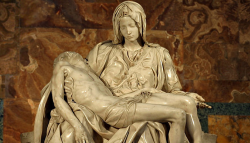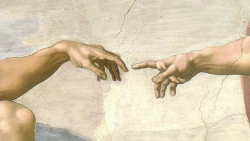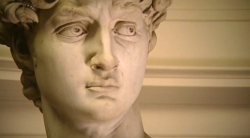Giotto, as it has been said, was very ingenious and humorous, and very witty in his sayings, whereof there is still vivid memory in that city; for besides that which Messer Giovanni Boccaccio wrote about him, Franco Sacchetti, in his three hundred Stories, relates many of them that are very beautiful. Of these I will not forbear to write down some with the very words of Franco himself, to the end that, together with the story itself, there may be seen certain modes of speech and expressions of those times. He says in one, then, to give it its heading:
“To Giotto, a great painter, is given a buckler to paint by a man of small account. He, making a jest of it, paints it in such a fashion that the other is put to confusion.”
The story: “Everyone must have heard already who was Giotto, and how great a painter he was above every other. A clownish fellow, having heard his fame and having need, perchance for doing watch and ward, to have a buckler of his painted, went off incontinent to the shop of Giotto, with one who carried his buckler behind him, and, arriving where he found Giotto, said, ‘God save thee, master, I would have thee paint my arms on this buckler.’ Giotto, considering the man and the way of him, said no other word save this, ‘When dost thou want it?’ And he told him; and Giotto said, ‘Leave it to me’; and off he went. And Giotto, being left alone, ponders to himself, ‘What meaneth this? Can this fellow have been sent to me in jest? Howsoever it may be, never was there brought to me a buckler to paint, and he who brings it[Pg 93] is a simple manikin and bids me make him his arms as if he were of the blood-royal of France; i’ faith, I must make him a new fashion of arms.’ And so, pondering within himself, he put the said buckler before him, and, having designed what seemed good to him, bade one of his disciples finish the painting, and so he did; which painting was a helmet, a gorget, a pair of arm-pieces, a pair of iron gauntlets, a cuirass and a back-piece, a pair of thigh-pieces, a pair of leg-pieces, a sword, a dagger, and a lance. The great man, who knew not what he was in for, on arriving, comes forward and says, ‘Master, is it painted, that buckler?’ Said Giotto, ‘Of a truth, it is; go, someone, and bring it down.’ The buckler coming, that would-be gentleman begins to look at it and says to Giotto, ‘What filthy mess is this that thou hast painted for me?’ Said Giotto, ‘And it will seem to thee a right filthy business in the paying.’ Said he, ‘I will not pay four farthings for it.’ Said Giotto, ‘And what didst thou tell me that I was to paint?’ And he answered, ‘My arms.’ Said Giotto,’ And are they not here? Is there one wanting?’ Said the fellow, ‘Well, well!’ Said Giotto, ‘Nay, ’tis not well, God help thee! And a great booby must thou be, for if one asked thee, “Who art thou?” scarce wouldst thou be able to tell; and here thou comest and sayest, “Paint me my arms!” An thou hadst been one of the Bardi, that were enough. What arms dost thou bear? Whence art thou? Who were thy ancestors? Out upon thee! Art not ashamed of thyself? Begin first to come into the world before thou pratest of arms as if thou wert Dusnam of Bavaria. I have made thee a whole suit of armour on thy buckler; if there be one piece wanting, name it, and I will have it painted.’ Said he, ‘Thou dost use vile words to me, and hast spoilt me a buckler;’ and taking himself off, he went to the justice and had Giotto summoned. Giotto appeared and had him summoned, claiming two florins for the painting, and the other claimed them from him. The officers, having heard the pleadings, which Giotto made much the better, judged that the other should take his buckler so painted, and should give six lire to Giotto, since he was in the right. Wherefore he was constrained to take his buckler and go, and was dismissed; and so, not knowing his measure, he had his measure taken.”
It is said that Giotto, while working in his boyhood under Cimabue, once painted a fly on the nose of a figure that Cimabue himself had made, so true to nature that his master, returning to continue the work, set himself more than once to drive it away with his hand, thinking that it was real, before he perceived his mistake. Many other tricks played by Giotto and many witty retorts could I relate, but I wish that these, which deal with matters pertinent to art, should be enough for me to have told in this place, leaving the rest to the said Franco and others.
Finally, seeing that there remained memory of Giotto not only in the works that issued from his hands, but in those also that issued from the hand of the writers of those times, he having been the man who recovered the true method of painting, which had been lost for many years before him; therefore, by public decree and by the effort and particular affection of the elder Lorenzo de’ Medici, the Magnificent, in admiration of the talent of so great a man his portrait was placed in S. Maria del Fiore, carved in marble by Benedetto da Maiano, an excellent sculptor, together with the verses written below, made by that divine man, Messer Angelo Poliziano, to the end that those who should become excellent in any profession whatsoever might be able to cherish a hope of obtaining, from others, such memorials as these that Giotto deserved and obtained in liberal measure from his goodness:
Ille ego sum, per quem pictura extincta revixit,
Cui quam recta manus, tam fuit et facilis.
Naturæ deerat nostræ quod defuit arti;
Plus licuit nulli pingere, nec melius.
Miraris turrim egregiam sacro ære sonantem?
Hæc quoque de modulo crevit ad astra meo.
Denique sum Jottus, quid opus fuit illa referre?
Hoc nomen longi carminis instar erit.
And to the end that those who come after may be able to see drawings by the very hand of Giotto, and from these to recognize all the more the excellence of so great a man, in our aforesaid book there are some that are marvellous, sought out by me with no less diligence than labour and expense.



